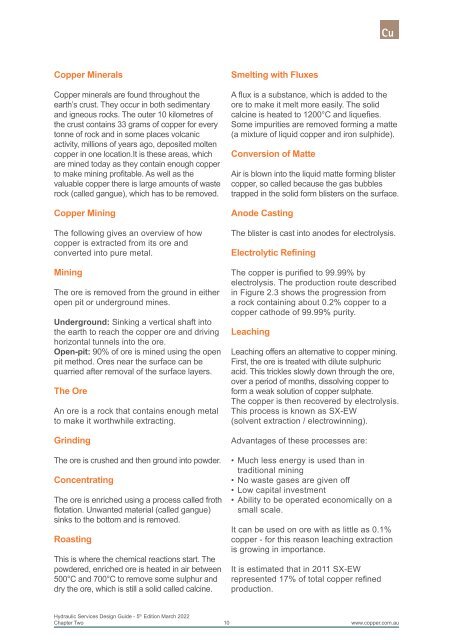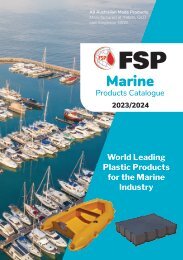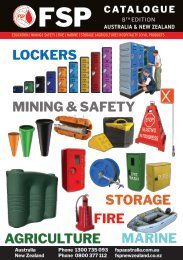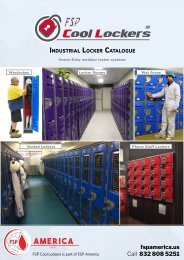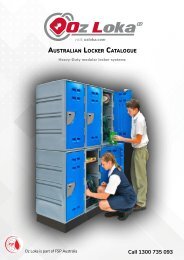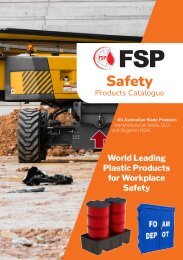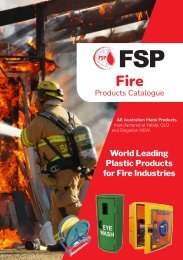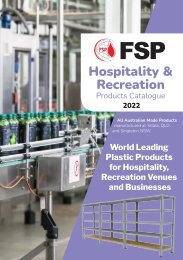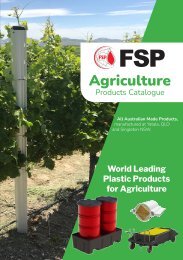Copper Alliance HSDG Australia
You also want an ePaper? Increase the reach of your titles
YUMPU automatically turns print PDFs into web optimized ePapers that Google loves.
<strong>Copper</strong> Minerals<br />
<strong>Copper</strong> minerals are found throughout the<br />
earth’s crust. They occur in both sedimentary<br />
and igneous rocks. The outer 10 kilometres of<br />
the crust contains 33 grams of copper for every<br />
tonne of rock and in some places volcanic<br />
activity, millions of years ago, deposited molten<br />
copper in one location.It is these areas, which<br />
are mined today as they contain enough copper<br />
to make mining profitable. As well as the<br />
valuable copper there is large amounts of waste<br />
rock (called gangue), which has to be removed.<br />
<strong>Copper</strong> Mining<br />
The following gives an overview of how<br />
copper is extracted from its ore and<br />
converted into pure metal.<br />
Mining<br />
The ore is removed from the ground in either<br />
open pit or underground mines.<br />
Underground: Sinking a vertical shaft into<br />
the earth to reach the copper ore and driving<br />
horizontal tunnels into the ore.<br />
Open-pit: 90% of ore is mined using the open<br />
pit method. Ores near the surface can be<br />
quarried after removal of the surface layers.<br />
The Ore<br />
An ore is a rock that contains enough metal<br />
to make it worthwhile extracting.<br />
Grinding<br />
The ore is crushed and then ground into powder.<br />
Concentrating<br />
The ore is enriched using a process called froth<br />
flotation. Unwanted material (called gangue)<br />
sinks to the bottom and is removed.<br />
Roasting<br />
This is where the chemical reactions start. The<br />
powdered, enriched ore is heated in air between<br />
500°C and 700°C to remove some sulphur and<br />
dry the ore, which is still a solid called calcine.<br />
Smelting with Fluxes<br />
A flux is a substance, which is added to the<br />
ore to make it melt more easily. The solid<br />
calcine is heated to 1200°C and liquefies.<br />
Some impurities are removed forming a matte<br />
(a mixture of liquid copper and iron sulphide).<br />
Conversion of Matte<br />
Air is blown into the liquid matte forming blister<br />
copper, so called because the gas bubbles<br />
trapped in the solid form blisters on the surface.<br />
Anode Casting<br />
The blister is cast into anodes for electrolysis.<br />
Electrolytic Refining<br />
The copper is purified to 99.99% by<br />
electrolysis. The production route described<br />
in Figure 2.3 shows the progression from<br />
a rock containing about 0.2% copper to a<br />
copper cathode of 99.99% purity.<br />
Leaching<br />
Leaching offers an alternative to copper mining.<br />
First, the ore is treated with dilute sulphuric<br />
acid. This trickles slowly down through the ore,<br />
over a period of months, dissolving copper to<br />
form a weak solution of copper sulphate.<br />
The copper is then recovered by electrolysis.<br />
This process is known as SX-EW<br />
(solvent extraction / electrowinning).<br />
Advantages of these processes are:<br />
• Much less energy is used than in<br />
traditional mining<br />
• No waste gases are given off<br />
• Low capital investment<br />
• Ability to be operated economically on a<br />
small scale.<br />
It can be used on ore with as little as 0.1%<br />
copper - for this reason leaching extraction<br />
is growing in importance.<br />
It is estimated that in 2011 SX-EW<br />
represented 17% of total copper refined<br />
production.<br />
Hydraulic Services Design Guide - 5 th Edition March 2022<br />
Chapter Two<br />
10<br />
www.copper.com.au


